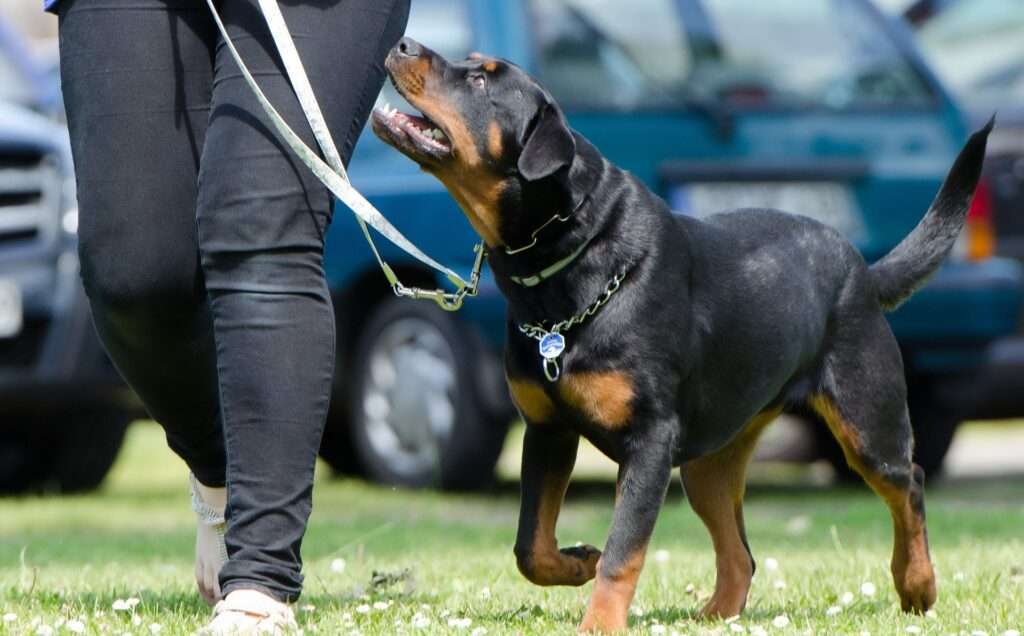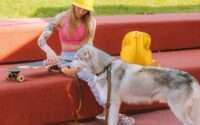Learn How to Teach a Dog to Heel: Say Goodbye to Leash Pulling!
Welcome to BarkLikeMeow’s comprehensive guide on how to teach a dog to heel! If you’re a dog owner, you know the importance of good behavior and obedience. One of the most crucial commands you can teach your dog is how to heel properly. Not only does it make walking your dog more enjoyable, but it also provides a foundation for other obedience training.
In this guide, we’ll walk you through the basics of heel training, including proper leash handling, choosing the right training tools, and the basic obedience commands your dog should already know.
Understanding Heeling

Heeling is the process of teaching your dog to walk closely by your side while on a leash. This is different from a regular walk where your dog may walk in front of you, pull on the leash or walk at their own pace. A dog that heels is not only easier to manage but also creates a stronger bond between the dog and their owner.
It’s important to understand that heeling is more than just a simple command, it’s a behavior that requires constant reinforcement and practice. Heeling is an important skill for any dog to learn, as it allows them to walk safely and confidently in public areas.
Dogs that heel are less likely to become distracted or reactive to other animals or people. This skill also helps dogs learn to follow and respect their owners’ commands and authority. By mastering heeling, you can provide your dog with a valuable skill that will benefit them for the rest of their life.
Preparing to Teach Heeling
Before you start teaching your dog to heel, there are a few important steps you need to take to prepare both yourself and your dog. Firstly, you need to make sure you have the right equipment. A properly fitting collar and a sturdy leash are essential. You may also want to consider using a treat bag to reward your dog during training.
Next, you need to choose a location for training. It’s best to start in a quiet area with few distractions, such as a fenced-in yard or a quiet park. Once your dog has mastered the basics, you can move on to busier areas with more distractions.
Finally, it’s important to get your dog in the right mindset for training. Make sure they are well-fed, have had a chance to go potty, and are feeling relaxed and focused. Keep training sessions short and positive to avoid frustrating your dog or causing them to become disinterested.
Step-by-Step Guide to Teaching Heeling
To start teaching your dog to heel, begin by practicing basic leash manners. Encourage your dog to walk at your side with a loose leash. When they do, reward them with treats and praise. If they start to pull, stop walking and wait for them to calm down before continuing.
Once your dog has mastered basic leash manners, start teaching them to respond to commands. Begin by using simple commands like “sit” or “stay” to get your dog used to following your lead. When they respond correctly, reward them with a treat and praise.
When your dog is comfortable responding to basic commands, it’s time to start working on heeling specifically. Start by walking a short distance with your dog by your side, rewarding them with treats and praise when they stay close to you. Gradually increase the distance and add in more distractions, such as other dogs or people walking nearby.
If your dog starts to pull or become distracted, stop walking and use a gentle tug on the leash to bring them back to your side. Encourage them to focus on you by using positive reinforcement techniques like treats and praise.
Remember, heeling is a behavior that takes time and practice to master. Be patient and consistent with your training, and always end on a positive note. With time and practice, your dog will learn to heel like a pro!
Troubleshooting Common Heeling Issues
Despite your best efforts, your dog may struggle with heeling at times. Here are some common issues and how to address them:
- Pulling: If your dog pulls on the leash, stop walking and wait for them to calm down before continuing. Use a gentle tug on the leash to bring them back to your side.
- Distractions: If your dog becomes distracted, use positive reinforcement techniques like treats and praise to encourage them to focus on you.
- Lack of interest: If your dog seems disinterested in heeling, try making the training sessions more fun and engaging. Use toys or play games to keep their attention.
- Fear: If your dog seems fearful or anxious, stop training and consult a professional dog trainer for assistance.
Above are some of the common issues that most owners face when teaching their dog to heel. With some level of dedication and patience, it is easy to overcome them and achieve the desired results.
Reinforcing Good Behavior

Once your dog has mastered heeling, it’s important to continue reinforcing good behavior. Here are some tips for maintaining your dog’s heeling skills:
- Consistency: Continue to practice heeling regularly to keep your dog’s skills sharp.
- Rewards: Use treats and praise to reward your dog for heeling correctly.
- Varied training: Mix up your training routine to keep your dog engaged and challenged.
- Gradual increase in difficulty: As your dog becomes more skilled, gradually increase the distance and level of distractions during training.
Don’t forget that heeling is a behavior that requires constant reinforcement and practice. By continuing to work with your dog, you can maintain their heeling skills and create a strong bond between you and your furry friend.
Advanced Training Techniques for Heeling
Once your dog has mastered the basics of heeling, you may want to try some advanced training techniques to further challenge and engage them. Here are some techniques to consider:
- Circle walking: This involves walking in a circle with your dog by your side. Gradually decrease the size of the circle as your dog becomes more skilled.
- Figure 8s: This involves walking in a figure 8 pattern with your dog by your side. Gradually increase the speed and complexity of the pattern as your dog becomes more skilled.
- Changing pace: Practice heeling at different speeds, such as slow, medium, and fast.
- Verbal commands: Once your dog is comfortable with heeling, start giving verbal commands instead of using physical cues. For example, say “heel” instead of using a hand signal.
Do keep in mind that these advanced techniques should only be attempted once your dog has mastered the basics of heeling. Always start slowly and gradually increase the difficulty as your dog becomes more skilled.
Conclusion
Teaching your dog to heel is an important aspect of responsible dog ownership. Not only does it keep your dog safe, but it also strengthens the bond between you and your furry friend. By using positive reinforcement techniques, practicing regularly, and being patient, you can successfully teach your dog to heel.
Remember, each dog is unique and may require different approaches when it comes to training. If you’re struggling with heeling or any other aspect of dog training, don’t hesitate to seek the help of a professional dog trainer. With time, practice, and dedication, you can help your dog become a well-trained and obedient companion.
We hope this comprehensive guide has provided you with the information and techniques you need to successfully teach your dog to heel. Happy training!
Frequently Asked Questions
Q: What is “heeling” and why is it important to teach my dog?
A: “Heeling” is the term used to describe the behavior of a dog walking calmly and obediently beside its owner with a loose leash. Teaching your dog to heel is important for several reasons. It promotes good leash manners, helps keep your dog safe by preventing them from running into traffic or other hazards, and strengthens the bond between you and your dog.
Q: How do I get my dog to walk beside me without pulling on the leash?
A: One effective method is to use treats to reward your dog for walking calmly beside you. Hold the leash in your opposite hand from the side your dog is walking on, and keep your hand at your waist. When your dog walks beside you without pulling on the leash, give them a treat. With practice, your dog will learn to associate walking calmly beside you with receiving treats, and will be more likely to do so in the future.
Q: What if my dog is already used to pulling on the leash?
A: It may take some time and patience, but it is possible to teach an older dog to heel. Start by practicing in a quiet, distraction-free environment and gradually increase the difficulty level as your dog becomes more comfortable with the behavior. Be consistent with your training and reward your dog for good behavior.
Q: How long does it take to teach a dog to heel?
A: The length of time it takes to teach a dog to heel depends on the dog’s age, breed, and temperament, as well as the consistency and effectiveness of your training methods. Some dogs may learn quickly, while others may take longer. It is important to be patient and consistent with your training, and to reward your dog for good behavior.
Q: What equipment do I need to teach my dog to heel?
A: All you need is a sturdy leash and a comfortable collar or harness for your dog. Choose a collar or harness that fits your dog properly and is appropriate for their size and breed.
Q: Can I use a retractable leash to teach my dog to heel?
A: It is not recommended to use a retractable leash when teaching your dog to heel, as it can be difficult to maintain control of the leash and keep your dog close to you. A standard leash is a better option for training your dog to walk calmly beside you.
Q: What if my dog gets distracted while we are walking?
A: If your dog gets distracted while you are walking, stop walking and wait for them to refocus on you. Once your dog is paying attention to you again, continue walking. You can also use treats or a favorite toy to get your dog’s attention and encourage them to walk beside you.
Q: Should I use a verbal command when teaching my dog to heel?
A: Yes, using a verbal command such as “heel” or “walk with me” can help your dog understand what you want them to do. Be consistent with your commands and use positive reinforcement to reward your dog for obeying.
Q: Can I teach my dog to heel off-leash?
A: It is possible to teach your dog to heel off-leash, but this should only be attempted in a safe, enclosed area. Make sure your dog is trained to obey verbal commands and is under control before attempting off-leash heeling.
Q: What if my dog continues to pull on the leash while we are walking?
A: If your dog continues to pull on the leash, stop walking and wait for them to calm down. Once your dog is calm, resume walking. You can also try changing direction or using a treat or toy to get your dog’s attention and encourage them to walk beside you without pulling.




